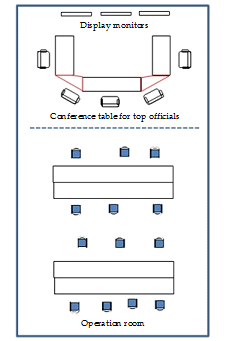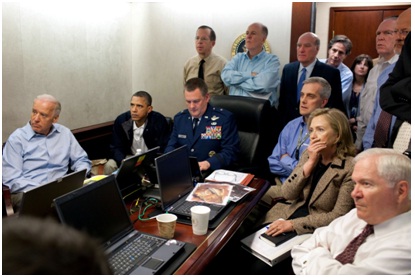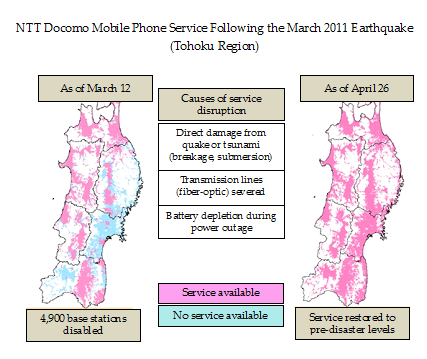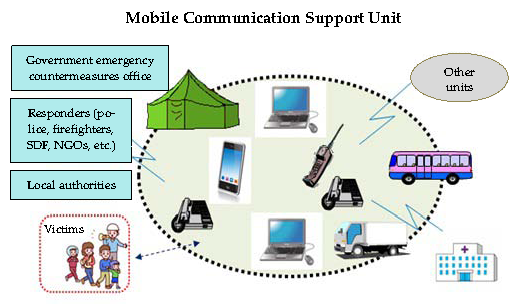- Policy Proposal
- Japanese Politics
Enhancing Preparedness: Proposals for Reinforcing the Government’s Crisis Management Capacity
May 28, 2012
The government's response to the disasters triggered by the Great East Japan Earthquake of March 2011 raised serious questions about Japan's ability to handle a crisis at the national level. Summarizing discussions held under the Tokyo Foundation ’s National Security Policy Project and drawing on his experience as special adviser to the cabinet between March and September 2011 , Noboru Yamaguchi offers proposals that stress the need to rethink crisis management in the age of advanced information and communications technology.
* * *
Introduction
Since spring 2011 the Tokyo Foundation's National Security Policy Project has been conducting seminars to formulate recommendations for emergency management policy at the national level with the lessons of the Great East Japan Earthquake in mind. Project members engaged in many hours of debate and deliberation on emergency management at the government level, with the aid of expert testimony on a wide range of relevant topics, including damage estimates and response planning for a major Tokyo earthquake; preparedness for emergencies involving cyberspace, outer space, or the oceans; and the state of Japan's existing emergency management system under the Cabinet Secretariat.
The key point that emerged from our hearings and deliberations was the importance of establishing a smoothly functioning decision-making cycle under which the government's top leadership can keep abreast of circumstances as they unfold, accurately assess the situation, decide on an appropriate response, and take effective action in a crisis situation. This is the process referred to in some circles as the OODA (observe-orient-decide-act) loop, a term originating in the US military. The success or failure of an organization's handling of a crisis has been shown to hinge in large part on the manner in which it navigates this cycle, and its importance has only increased with the rapid rise and diffusion of advanced information and communications technology in recent years. This understanding is a central theme of the recommendations summarized below.
Recommendations
In the following I draw from the results of our study to propose key priorities that the Japanese government needs to address in order to improve emergency management at the national level. I present these recommendations in hopes of stimulating a productive debate on this critical topic.
1. Prepare for a wider range of contingencies by "anticipating the unanticipated"
A. Initial response under Japan's current system
In the face of widespread criticism of the government's slow early response to the Great Hanshin-Awaji Earthquake of January 1995, the nation's crisis management apparatus underwent a number of reforms. As an example, the Cabinet Information Collection Center and Crisis Management Center now operate on a round-the-clock basis. The government also instituted a system, applicable in the event of any contingency that meets the definition of an emergency situation (large-scale disasters, major accidents, major incidents, armed attacks, etc.), under which an emergency response team consisting of high-level officials from concerned ministries and agencies gathers at the Crisis Management Center of the Prime Minister's Office to draw up emergency countermeasures.
In addition, to ensure a smoothly coordinated early response to these emergencies, the crisis management units of concerned ministries and agencies prepare by taking part in tabletop exercises and other drills. On March 11, 2011, the day of the Great East Japan Earthquake, the emergency response team convened in the Prime Minister’s Office just 15 minutes after the quake struck. Within 50 minutes, the first meeting of the emergency countermeasures headquarters, chaired by the prime minister, was in session.
B. The need to prepare for a wider range of contingencies
"Emergency response situations," as defined by the Cabinet Secretariat's crisis-management apparatus (that is, the Crisis Management Center in the Prime Minister's Office) includes the following:
(1) Large-scale disasters (earthquakes, storms, volcanic eruptions)
(2) Major accidents (airplane crashes, maritime accidents, accidents on the rail or highway system, accidents involving hazardous materials, large fires, nuclear accidents)
(3) Major incidents (large-scale terrorist attacks, cyber-terrorism, hijacking or hostage taking, incursion by suspicious marine vessels, missile launches)
(4) Armed attack situations
(5) Others (rescue of Japanese nationals, massive influx of refugees, new strains of influenza, nuclear tests, piracy, etc.)
In such emergencies, state and local public institutions—including the Self-Defense Forces, the Coast Guard, police and fire departments, traffic and transportation authorities, public medical facilities, and immigration authorities—must be prepared to respond. The private sector, too, such as private companies, nongovernmental organizations, healthcare providers, media organizations, scientists, and engineers, may be called upon to play an important role, depending on the nature of the situation. And in a serious emergency, it goes without saying that the national government must exercise calm and effective leadership at the highest levels.
Even if the situation does not require an emergency response, the nation's top leadership might be called on to make urgent decisions or clarify its position. Such contingencies may fall outside the traditional purview of crisis management, but the chief executive should nonetheless be prepared to make decisions on the basis of up-to-date information. Emergency procedures relating to the collection of information, transmission of that information to top government leaders, and the swift and coordinated response by relevant government units based on the decisions made should also apply to the following contingencies, for example:
- Crises involving the international financial system, such as the collapse of the market for government bonds or other securities, a government default, or the failure of major financial institutions
- Threats to the import of food, energy, rare materials, or other key resources into Japan owing to natural phenomena or international conflicts (extreme weather conditions, armed conflict in the Persian Gulf, etc.)
- Serious humanitarian emergencies (outbreak of refugees fleeing famine, armed conflict, etc.)
- Emergency situations in cyberspace or outer space
- Emergency situations involving overseas activities of Japanese government organs, including peace-keeping operations by the Self-Defense Forces
To facilitate decision making in a wide range of emergency situations, it is vital that support for such decisions be offered from the perspective of the nation’s top leaders, not from the viewpoint of the individual ministries or agencies with jurisdiction over a given situation. For this reason, the purview of the organizational units and top posts devoted to crisis management should be as comprehensive possible. In an emergency management system, redundancy is preferable to deficiency.
Currently, the deputy chief cabinet secretary for crisis management directs the Cabinet Secretariat's crisis-management apparatus during emergencies, "except for those pertaining to national defense." The drafters of this provision may have thought it prudent to distinguish between contingencies pertaining to national defense and other emergencies, but in the real world, seemingly isolated incidents, such as a missile launch or incursion by a suspicious vessel, can subsequently develop a into armed attacks. Given this possibility, I see no good reason to expressly exclude situations pertaining to national defense from the jurisdiction of the deputy chief cabinet secretary for crisis management.
C. Preparing for "unanticipated events"
As previously suggested, a comprehensive list of the types of emergencies that call for intervention by government leaders must be prepared and revised as necessary based on up-to-date information. In many countries, this is one of the key roles of the national security council under the chief executive. Prime Minister Shinzo Abe called for the establishment of an advisory body comparable to the US National Security Council back in 2006, and the Democratic Party of Japan has been studying a similar policy since coming power in 2009. At present, however, there is no organ in Japan charged with this task. The National Policy Unit in the Cabinet Secretariat advises and coordinates for the achievement of long-term policy goals, but it is not charged with emergency management.
Given the relentless day-to-day demands of government affairs—domestic and foreign—government leaders need the support of close advisers who can devote their time to imagining the unimaginable, unhampered by the political demands of the moment. An elite group of experts with no duties other than anticipating possible emergencies should be understood as a vital component of any Japanese national security council.
2. An optimum decision-making environment based on accurate information
A. The need to facilitate information access
The Crisis Management Center was set up promptly in the Prime Minister's Office after the March 11 earthquake, and it functioned effectively in the earliest stages by conveying information to the relevant ministries and agencies via the emergency response team. However, once rescue and relief operations were underway in the individual ministries and agencies and the normal chains of command had begun functioning again, the Crisis Management Center proved unwieldy and ineffective as a means of compiling information on those disparate operations and making it accessible to the prime minister and his staff.
Moreover, because access to the center was strictly controlled in the name of information security, use of key channels of communication, including mobile phone access, was restricted. As a means of keeping abreast of the situation in order to make timely and appropriate decisions, the Crisis Management Center was not a user-friendly tool.
In seeking a solution to the problem, the Prime Minister's Office should follow the example of the Ministry of Defense. In the basement of MOD Headquarters is a command center whose function is much the same as that of the Crisis Management Center in the Prime Minister's Office, gathering information from sources of every kind and displaying it on large screens. (Using these capabilities, the chief of the Joint Staff Office was kept informed of the situation in the affected areas and the progress of SDF rescue and relief operations following the March 2011 disaster and was able to advise the defense minister on such matters as the dispatch of additional units.) On the same floor as the defense minister's office, moreover, a Situation Room was set up, giving the minister and other top officials easy access to relevant, up-to-date information—presumably, information of particular interest to top defense officials, extracted from the masses of data reaching command center.
Layout of the Defense Ministry Situation Room

In a crisis or emergency, the government's top leadership must be provided with an environment in which it can stay abreast of any new developments of concern and deliberate responses. Of course, at the height of a serious crisis, such as an armed attack, the Crisis Management Center would perform this function. However, it is scarcely practical for the prime minister to hole up in the Crisis Management Center before an emergency actually precipitates or after the peak has passed. To provide easy access to information in all but the most critical stages of a crisis, the Prime Minister's Office should be equipped with a situation room located on the same floor as the executive office, where data can be accessed in a more streamlined form.
At a minimum, the following types of information should be available in the situation room in order to keep the top leadership abreast of any emergency situation on an ongoing basis: (1) a situation map or maps, (2) a situation chronology, (3) images and other information from the scene of the crisis, (4) any other relevant information from the Crisis Management Center, Information Collection Center, or relevant ministries and agencies on topics of particular concern to the leadership.
A situation room can be made even more useful by allowing it to double as a kind of permanent information gateway for matters of special concern to government leaders. For example, when concern about the state of the world's financial markets is high, the room could display simple graphics showing the movements of stock, bond, and currency markets around the world. If more detailed information is required, the system could offer quick access to officials in the relevant section of the Ministry of Finance. If the problem is piracy off the coast of Somalia, the situation room could provide real-time information on SDF operations and the location of various ships in the region. This way, if a genuine emergency does develop, the government would be able to shift to a crisis-management mode on a moment's notice.
The type of information displayed and the manner it is shown would be variable, depending on both the decision-making style of the prime minister and the nature of the situation. One also would need to be prepared to shift the focus as the situation developed. The main thing is to ensure sufficient flexibility to adapt to the needs and wishes of the decision maker.

3. Enhancing information and communications infrastructure
A. The importance of information and communications infrastructure
One of the most important lessons from the Great East Japan Earthquake is the vital role played by the information and communications infrastructure. The earthquake and tsunami knocked out landline and mobile telecommunications services throughout the hardest-hit areas by severing conventional and optic-fiber transmission lines and damaging, destroying, or interrupting power to base stations. Communities along the Sanriku coast of northeastern Honshu, with its indented ria coastline, found themselves completely cut off, unable to share information even with neighboring municipalities. As a result, it was impossible for responders to gauge the seriousness of the situation. Even two weeks after the tsunami, when the need for supplies and other assistance had become critical, authorities were still unable to pin down the location and needs of many of the communities whose lifelines had been severed. The damage to communications infrastructure also hindered coordination and information sharing among the various responders taking part in relief efforts, from SDF troops and firefighters to volunteer groups and international organizations. In many cases the emergency supplies that prefectural authorities had readied in warehouses in the event of such a disaster never reached the evacuation centers that needed them, whether because of transport problems or because the center was unable to communicate its needs. In disaster-stricken areas, the efficient flow of information between the demand and supply sides is of the essence.

B. Satellite backup and emergency restoration
Inasmuch as the disruption of communications was a problem for the stricken Tohoku region in the aftermath of the Great East Japan Earthquake, thought must be given to the impact a major quake in the Tokyo area would have on vital communication networks in the nation's capital, including those of the Prime Minister's Office. A backup satellite network is needed to ensure that channels remain open between key cabinet members and other vital personnel during such an emergency.
Assuming that certain parts of the Tokyo-area telecommunications network will remain functional even in a worst-case scenario, planners should also establish procedures for linking them together to restore communications on an emergency basis.
When the March 2011 tsunami struck, the wireless Personal Handy-phone System ordinarily used for communication within the Fukushima Daiichi Nuclear Power Station complex was immediately rendered useless. But authorities in Tokyo were able to maintain email and teleconferencing contact with the plant thanks to a private line linking Fukushima Daiichi to the Tokyo headquarters of TEPCO (Tokyo Electric Power Company). By March 26, moreover, this company network and been linked up with a mobile base station set up in the compound, permitting the restoration of mobile-phone communications inside the plant complex.
In addition to the government-only networks used by various ministries (including the SDF) and the public network operated by NTT and other telecom carriers, most businesses that operate and maintain the capital area's power and transportation infrastructure have their own dedicated communication networks. By creating an ad hoc network from those elements that remain functional, it should be possible to restore vital information and communications service on an emergency basis.
C. Backup communications equipment and services
One international NGO that assisted with rescue and relief operations after the March 2011 disaster was the International Medical Corps. The first thing it did upon arriving in a stricken area was to distribute telecommunications devices, including iPads, iPhones, and satellite phones. By so doing, it could quickly ascertain what sort of medical assistance was needed, and where. Until wireless phone service was restored at the Fukushima Daiichi Nuclear Power Station, plant personnel were able to make do with a combination of iridium satellite phones and a multichannel access radio communication system stored on site for emergency purposes. Distribution of emergency communications devices and the creation of ad hoc networks to ensure the smooth flow of critical information can play a vital role in emergency response.
Information and communications services for disaster-hit communities should be considered a priority comparable to food, clothing, shelter, and medical care. By dispatching small, autonomous teams equipped with a variety of information and communications equipment ("mobile communication support units") to set up ad hoc networks in disaster areas, we could facilitate the flow of information between the demand and supply sides of the rescue and relief equation. Just as there are various NGOs dedicated to providing food and medical care, organizations to provide information and communication services might need to be set up.

Emergency management today must take into account the unprecedented speed at which information flies around the globe via Internet blogs and such social media as Twitter and Facebook. As a result of these new developments in information and communication technology, news or rumors of an event can reach people around the world almost instantaneously, but such reports are not always accurate. This makes it more important than ever before that the government broadcast messages to the nation and the world in a clear and timely fashion during emergencies. In a crisis of the magnitude of the March 2011 disaster, the quality of public information coming out of the Prime Minister's Office is of the essence.
The report of the Independent Investigation Commission on the Fukushima Daiichi Nuclear Accident issued by the Rebuild Japan Initiative in February this year devotes a substantial number of pages to the issue of risk communication. The report discusses the manner in which the government sought to address concerns over the accident both in Japan and overseas, assessing the strengths and weaknesses of its public communications efforts, including its explanations of the risks of radiation exposure and its statements to the foreign media.
At crucial junctures in an emergency situation, the prime minister certainly needs to appear before the nation and the world and address them in his or her own words. However, the report makes the case that the prime minister was provided with insufficient support to communicate effectively with the public. When and how the prime minister should stand and speak before a domestic or foreign audience is a crucial judgment call for the administration as a whole; it is therefore of the utmost importance to equip the prime minister with expert staff to advise him on such matters.
The chief cabinet secretary played an essential role in providing the media with regular updates during and after the emergency. But in a situation like the March 2011 disaster, the task can become too much for one person, particularly given that the chief cabinet secretary, as the prime minister's chief of staff, also performs a vital role of coordinating the work of the ministries and agencies. At times when the chief cabinet secretary is under intense pressure to perform the latter duties, responsibility for dealing with the press might need to be delegated to a deputy chief cabinet secretary or another member of the cabinet. Considering the importance of this function during crisis situations, a quasi-cabinet post of press officer may need to be created.
At the same time, there is an urgent need to enhance the Japanese government's capacity to provide information in English and other key languages in order to improve communication with the rest of the world and ensure that foreign nationals in Japan receive warnings and other vital information in a timely and accurate manner.
Conclusion
In this brief paper, I have focused on three key imperatives for effective emergency management in Japan: (1) "anticipating the unanticipated" to prepare for a wider range of contingencies, (2) creating an optimum decision-making environment based on accurate information, and (3) enhancing information and communications infrastructure. In some sense, all of the recommended reforms—including measures to ensure effective communication with the international community—point to a greater emphasis on information and communication. In a nutshell, the government must rethink crisis management in the context of the changes being ushered in by the information revolution that are, in many ways, as momentous as those triggered by the Industrial Revolution.
